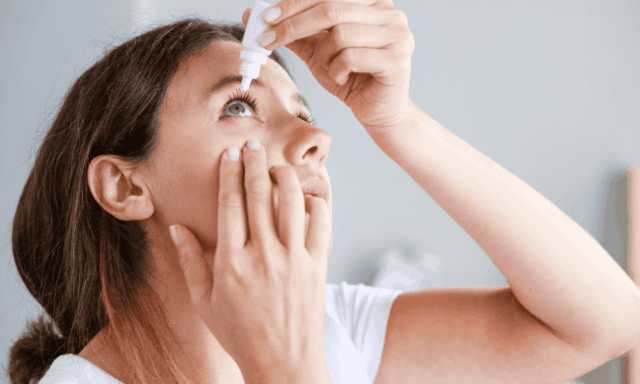Pharmacologic treatments for presbyopia promise to give patients freedom and flexibility in the midst of busy careers and active lifestyles. They’re non-invasive, they’re adjustable, they’re situation-specific. But patients are missing the boat because their optometrists haven’t discussed it with them. Jacob Lang, OD, FAAO, called it out at CIME 2025 to Optometry Times:
Some of the barriers that patients run into with regards to pharmacologic correction and presbyopia … I think one of the biggest ones is their providers. It’s actually the doctors not knowing what options are out there with regards to pharmacologic correction and how those pharmacologic options might benefit their patients in their chairs. So furthering their education, embracing new things … I think that’s the biggest thing and the biggest barrier to patients getting access to these options.
This week, Optometry 411 explores presbyopia drops: What’s the latest? What’s in the pipeline? What do you need to know?
Who are the best candidates?
Presbyopia drops work best for:
- Early to moderate presbyopes (typically age 40–55)
- Emmetropic patients with good distance vision
- Highly motivated individuals seeking to reduce dependence on readers
- Post-LASIK patients frustrated by the onset of presbyopia
Patients with significant cataracts, retinal pathology, or severe dry eye are not ideal candidates. Pupil size, while a factor, isn’t as critical as motivation and ocular health. Also at CIME 2025, Selina McGee, OD, FAAO, emphasized that it’s less about the perfect measurement and more about the patient’s willingness to try something new.
And drops aren’t meant to replace existing solutions. They can complement progressive lenses, monovision or multifocal contact lenses, or surgical interventions. They can be a tool for workdays, social events, or travel. McGee urged ODs to educate patients that they can combine options based on their lifestyle needs.
Here’s an important point from Marc Bloomenstein, OD, FAAO, in his deep dive on presbyopia eye drops (which we recommend reading).
Presbyopia drops aim to restore near vision by targeting the size of the pupil and thus inducing an extended depth of focus. A very important and distinct feature to note is that we are not inducing accommodation; thus, there is not an enlargement of text on the page or screen, as you would experience wearing readers, for instance. When patients who have myopia look through a progressive lens or multifocal contact lens, they are magnifying the image. Presbyopia drops do not have the same magnifying effect and therefore, as with any new treatment, they have an adaptation curve. There is, and will be, an adaptive period that is needed to allow the visual system to align with these new modalities.
Available and emerging drops
Current options:
Vuity (pilocarpine 1.25%)
- The first FDA-approved presbyopia drop (2021)
- Works by inducing miosis to increase depth of field
- Uses a proprietary rapid pH-shifting mechanism (pHast™) designed to enhance absorption
- Onset: ~15 minutes, duration: up to 6 hours
- Common side effects: Headache, brow ache, eye redness, and reduced night vision due to pupil constriction
- No ocular surface lubricant in the formulation, which might contribute to stinging or burning on instillation, especially in patients with dry eye
- See Vuity prescribing information
Qlosi (pilocarpine 0.4%)
- FDA-approved in 2023
- Also induces miosis via pilocarpine
- Lower pilocarpine concentration → fewer side effects (and slower onset but greater comfort on instillation)
- Onset: ~20–30 minutes, duration: up to 6 hours
- Soothing vehicle formulation helps support the ocular surface, which is often compromised in presbyopic patients
- Ideal for those who experienced discomfort with higher concentrations
- See Qlosi prescribing information
Another CIME 2025 attendee, Neda Shamie, MD, pointed out that many presbyopic patients also suffer from dry eye or ocular surface irritation, and that Qlosi’s dual-action design addresses both issues simultaneously.
In the pipeline:
The presbyopia treatment space is expanding rapidly. According to DelveInsight’s 2025 Presbyopia Pipeline Report, there are more than 10 active companies and 10+ therapies under development. Here’s a few notables:
- LNZ100 (aceclidine) by Lenz Therapeutics has a PDUFA date of August 2025 and may offer improved tolerability
- BRIMOCHOL™ PF, a fixed-dose combo of brimonidine and carbachol, has been submitted to the FDA and aims to extend duration while minimizing side effects
- Nyxol (phentolamine 0.75%) uses a novel mechanism — alpha blockers — to modulate pupil size and is currently in Phase III trials
- Microdosed delivery systems (like Eyenovia’s MicroLine) and lens-softening agents (like LX-OPH-162) are also in development
A note on barriers:
Many of these newer therapies still lack long-term efficacy data. Drop-based regimens have presented challenges in patient compliance in the past, as we know from glaucoma treatment studies. Cost will likely be a concern for patients; right now, Vuity and Qlosi are considered elective, lifestyle-enhancing treatments and are not covered. On the provider side, we expect some will wait to see which brands rise to the top (that, combined with a desire to wait for post-market experience, will likely be the main factors to slow widespread use).
You’ll want to weigh all this and offer pharmacologic presbyopia options to the right patients, thoughtfully and selectively. You might start with a simple in-office trial protocol, measuring near and distance acuity before and after a single drop.
To help refine your internal guidelines for who responds well and who doesn’t, consider scheduling a follow-up in 1–2 weeks to reassess efficacy, ask about side effects, and discuss lifestyle fit and ongoing usage (or else other options).
This content is intended for educational purposes only and does not substitute for clinical judgment. Treatment decisions should be based on individual patient needs, professional guidelines, and a comprehensive clinical evaluation.





